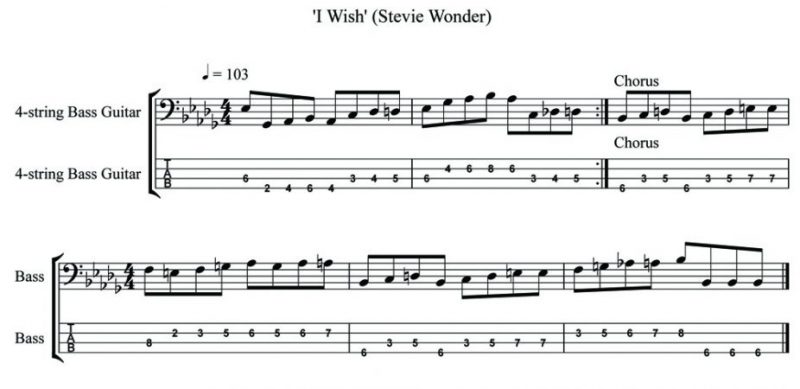Deep Thinking: Keyboard Bass + Bass Guitar = Huge Bass!
Deep Thinking: Keyboard Bass + Bass Guitar = Huge Bass!
This Deep Thinking bass lesson concerns how two sources of bass in a band can sound big and grunty (is that a word?). I did loads of adverts and television soundtracks between the 1970s and 1990s that combined a synth bass, played by a keyboard player, and my bass guitar.
You need to find two bass sounds that complement each other, and, most importantly, you and the keyboard player need to be extremely accurate. There is nothing worse than two bass notes out of sync and out of time!
I have transcribed two tracks (both from the 1970s when the technique started to become trendy and when synths started to have major technological sonic advances). The first is I Wish (1976) by Stevie Wonder, who played the synth bass part. The bass guitar was played by Nathan Watts, who is still Wonder’s bassist. The bass line consists of quavers (1/8 notes) throughout and is loosely constructed from an Eb Phrygian scale, although Stevie Wonder, like many Tamla Motown performers and composers, draws on his jazz background and puts several chromatic passing notes into the line.
The easiest way to play this line is to position your fretting hand so that bar 1 can be played between frets 2 and 6, and bar 2 can be played between frets 4 and 8. Obviously, you will need to move your fretting hand between the two positions. The chorus can be played in one position between frets 4 and 8, just watch out for the notes that are changed because of the key signature.
The second bass line comes from River People (1978) by Jaco Pastorius of Weather Report. Pastorius also played drums and timpani on the recording. Most of the line consists of octaves, and it will be a great workout for your alternate string picking (using strings 3 to 1 and 4 to 2).
The synth bass part (played by Weather Report founder and keyboard player, Joe Zawinul) is very closely mixed with Pastorius’ bass guitar but have a look at one of the live versions of the tune on YouTube and you can hear the two instruments more clearly. I have transcribed three sections of the tune. The first two bars are the first bass entry, and from a harmonic perspective, are simpler than Stevie Wonder’s line. That said, try playing it at speed! It should be attempted slowly at first and you can gradually push up the tempo.
The second part (at 54 seconds) is where the main body of the piece starts. There are several deviations not featured here that Pastorius adds to provide even more interest but you can see that, apart from the work your picking hand, or your plectrum picking, will be doing, your fretting hand will be moving around the neck. There is a lot to think about so, do it slowly at first!
The third section, now up a semitone, (at 3 minutes 32 seconds) is perhaps the hardest part, even though it is played between frets 1 and 3. This is a major workout for your picking hand and you will notice the quaver accent at the end of bar 1. This two bar figure features both alternative and adjacent (strings next to each other) string picking and you should aim to play the line very crisply and smoothly. You might even want to ask a keyboard player friend to add some synth bass! Explore some Weather Report on YouTube if you are unfamiliar with the band. Until next time, enjoy!
Dr. Rob Burns is an Associate Professor in Music at the University of Otago in Dunedin. As a former professional studio bassist in the UK, he performed and recorded with David Gilmour, Pete Townsend, Jerry Donahue, Isaac Hayes, Sam and Dave, James Burton, Ian Paice and Jon Lord, Eric Burdon and members of Abba. He played on the soundtracks on many UK television shows, such as Red Dwarf, Mr. Bean, Blackadder, Not the Nine O’Clock News and Alas Smith and Jones. Rob is currently a member of Dunedin bands Subject2change and The Verlaines.


